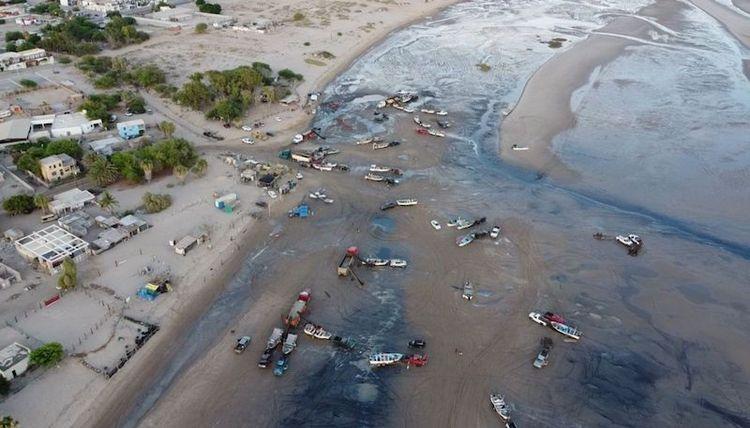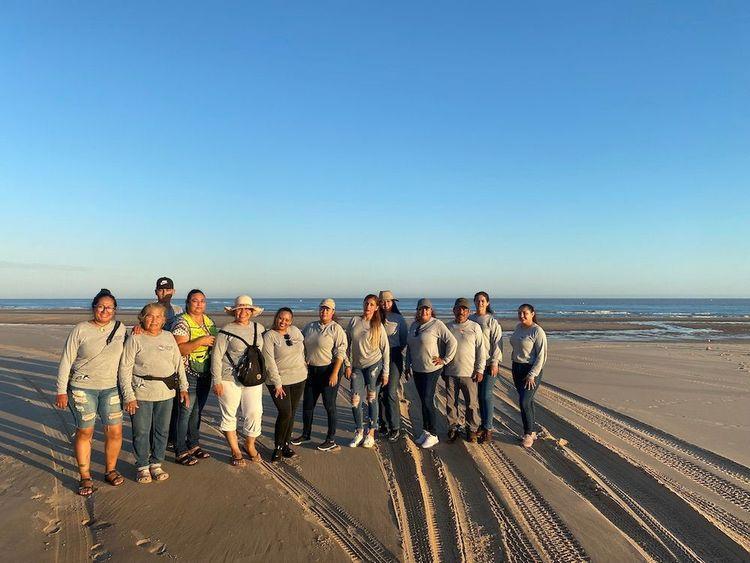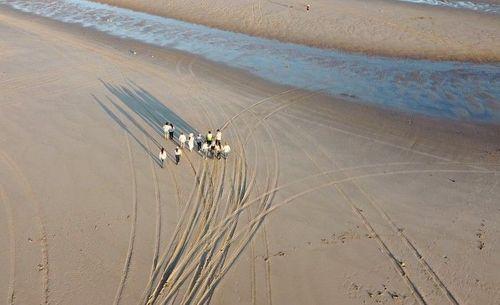San Luis Rio Colorado, Sonora.- It's the sunset in the Gulf of Santa Clara and the combination of the sea, the rays of the sun and the sound of the water create an almost immaculate image that is stained by the tire mark in the sand, from one side to the other all along the riverbank.
The constant presence of cars, whether due to family coexistence, reunion with friends or to remove small boats, has endangered a fish that only spawns in this place: the finch.

Photo: Ramsés Baduqui
The Gulf of Santa Clara is a fishing town in Sonora, approximately 590 kilometers from Hermosillo, the capital city, and is part of the Upper Gulf of California, where it forms a vertex with Baja California.
During April and May, this place presents a natural spectacle that attracts domestic and foreign tourists: the spawning of the flint (Leuresthes sardina), the only fish that lays its eggs out of the water.
Photo: Adriana Hernández
The pejerrey, also known as the grumpy Gulf, is a sardine-like, silvery-blue animal with a historical distribution from Guaymas, in Sonora, to Concepción Bay, in Baja California, and although it lives in different territories, it spawns only in the Gulf of Santa Clara due to the conditions of its beaches.
Human impact activities, such as uncontrolled fishing and irresponsible tourism, have affected and reduced the populations of the finch, leading it to be added to the list of Official Mexican Standard 059, in the Danger of Extinction category in 2019.
The disturbance of tourists who catch fish for fun, the use of motorized transport on the seashore, people walking and, as a consequence, the compaction of the sand, have caused a decrease in the population, but also in spawning time and the size of the reproducers.
Photo: Adriana Hernández
While between 1968 and 1973 the average duration of spawning was 81.23 minutes, according to research conducted by Donald Thomson and Kevin Muench (1976), another check carried out in 2015 showed a result of 10 minutes less spawning.
“Currently, the difference between the lengths and the duration of spawning indicates the urgency of regulating extraction and protecting the incubation sites of the species,” the authors Roberto Carmona, Adriana Hernández-Alvarez, Betsy Martínez-Reséndiz, Gorgonio Ruíz-Campos, José de la Cruz-Agüero, Ricardo Saldierna, Víctor M. Cota-Gómez, Martín Hernández-Riva and Gustavo D. Danemann wrote in the article “Biology and conservation of the pejerrey (Atherinopsidae, Leuresthes sardine)”, published by the Fishery Science Magazine of the National Institute of Fishing.
In the text, they pointed out that there are three intrinsic factors that make the finch species particularly vulnerable: its limited geographical range of reproductive distribution, its strategy and the reproductive dependence on sandy beaches in the area.
The establishment of aquacultural farms, which modify soil and alter hydrological patterns, also results in a species currently in a high degree of vulnerability.
The proposal to include finches as an endangered animal does not seek to prohibit fishing, but rather to provide protection by regulating certain activities such as consumption, to limit only months outside the season of heavy spawning.
Since 2017, biologist Adriana Hernández Álvarez has collaborated in the development of the proposal to include the finch in the NOM-059-SEMARNAT along with nine other experts in the field.
“What we had taken about population structure, length, weight, females, males and ages, we compared it with the only other data that exists that is 50 years old generated by researchers at the University of Arizona and the differences we found showed that fish are smaller now and that they spawn for less time,” he said.
“These responses are the first that a population presents when it is under strong pressure, and in terms of fisheries it is when a population is overfished, and although the finch is not fished commercially, it was not an overexploitation that is affecting it, but we do believe that the traffic of vehicles means that eggs do not hatch and there are fewer individuals, which causes smaller individuals to reproduce.”
The stingray fish serves as food for 36 species of birds and seven of them, or 20 percent, are included in NOM-059-SEMARNAT-2010: four under special protection, two threatened and another in danger of extinction.
“The couple with whom we have seen that they have a close relationship is with the reddish beach, which feeds on the eggs left by the stingray, but it is not the only one with whom it is connected. It is also prey to totoaba, croaker, sharks and 36 other bird species.”
“Without a doubt, with the disappearance, the species that would be most affected are shorebirds and in particular the reddish beach, because this site supports about 50 percent of its population. The loss of ecological balance would be dangerous for the species,” Hernández Álvarez shared.
Photo: Adriana Hernández
This reality is what prompted the creation of the group calling itself “Pejerreynas of the Gulf of Santa Clara”, a community of ten women and two men dedicated to protecting the species through awareness-raising activities and conservation work.
In 2014, they decided to join forces with the regional office of the National Commission for Protected Natural Areas (Conanp), with whom they have worked tirelessly for eight years. They have also collaborated with community biologists, the civil association Pronatura Noroeste and the Intercultural Center for the Study of Deserts and Oceans (CEDO).
Ciry Aldama Rivera is the leader of the group. Among all those present, eyes are turned to her to listen to her and learn. He doesn't just lead them. It guides them. It helps them. It organizes and promotes them in each activity.
“The Pejerreynas of the Gulf of Santa Clara are a community group that began to form little by little and we have been here since 2014 until today. We started as a volunteer group and so we joined one by one and there are already 12 of us, hoping to be more,” said Aldama Rivera.
“We already know the date and time when it is going to spawn, how long it will take, what time it is going to leave, we already have the calendar. All based on the experience we have gained in these eight years.”
Norma Soraida González Bernal is another member of the group and, together with her colleagues, they work not only during May and April, but all year round on different information campaigns on the beach, with talks in schools to bring children closer to environmental issues and, above all, to raise awareness, aimed at creating a rapprochement between the residents of the place and the species.
“We are also carrying out chinchorros surveying all along the shore of the beach because that's where the birds get stuck and when the finch spawns it also gets stuck and can't finish doing its job.”
“We do beachfront cleaning campaigns to remove garbage. We found glasses and bottles with flints inside and eggs outside,” he said.
The group currently consists of Alejandra Ramos, Mariel Aguilar, Jesús García, Ciry Aldama, Teresita Félix, Elizabeth Carrillo, Alma Sánchez, Yasmin Flores, Yabiel Ocegueda, Lorena Tapia, Sory González and Elena Bernal.

Photo: Adriana Hernández
When they were formed, in 2014, the citizen's response was not what they expected. Ignorance and uncertainty on the part of other inhabitants generated a rejection of the Pejerreynas of the Gulf of Santa Clara.
However, eight years after its creation, the positive impact of the activities carried out by the group and supported by different institutions, has been recognized by organizations that work for the environment in Sonora.
Nélida Barajas Acosta, executive director of the Intercultural Center for Deserts and Oceans Studies (CEDO) in Puerto Peñasco, said that these women and men have achieved a local change in their role as guardians of the fish.
“We are simply talking about the fleurrey and they are the pejerreynas, the guardians of the pejerreyes. It's not about going and simply placing restrictions on who sees them, how they see them, but they also do environmental education actions,” he said.
“The bullfights where you see the reproduction take place in a specific period and they don't just work at those times. They also monitor shorebirds, they welcome visitors, then you turn an everyday activity into a life action.”
Donald A. Thomson, who died in May 2022, was an important researcher at CEDO and provided relevant information about the species, especially in a context where even the basics of the animal were unknown. Their findings were an important part of the research that succeeded in integrating the pejerrey into the NOM-059-SEMARNAT, Barajas Acosta said.
“This was one of their shared passions. He was very interested in the subject of fish and this was a very peculiar one, coming out of the water and doing something different from the others in a megadiverse environment.”
“One way in which we want to honor their memory is that every year we will offer technical and educational support with the Pejerreynas of the Gulf of Santa Clara in their honor.”
Through the National Commission for Protected Natural Areas (Conanp), an economic resource is allocated as part of the Program for the Protection and Restoration of Ecosystems and Species at Risk (Prorest), which is used in the conservation activities carried out by the group.
According to statements from members, there is no other financial support and the City Council of San Luis Rio Colorado, to which the Gulf of Santa Clara belongs, does not have a specific program or resource dedicated to the protection of the finch.
Proyecto Puente requested an interview with the City Council of San Luis Rio Colorado and with the National Commission for Protected Natural Areas to obtain information about the support granted to the Pejerreynas group, but there was no response at the time of this publication.
Currently, the 12 members are carrying out cleaning work on the beach to take care of the area prior to the next spawning season, and they said they needed financial support from the three levels of government to continue with the different tasks that range from collecting to transporting waste.
Mothers of families, volunteers, educators. They save the finch from extinction every day through their information and conservation work, their approach to citizenship and their constant training.

Photo: Ramses Baduqui.
The Pejerreynas of the Gulf of Santa Clara have marked a turning point in their town, but they are also constantly becoming an example for other fishing communities that seek to protect their own species.
*This work was supported by the Sea Journalism Network (Repemar) provided by Causa Natura and the Earth Journalism Network of Internews.






Comentarios (0)